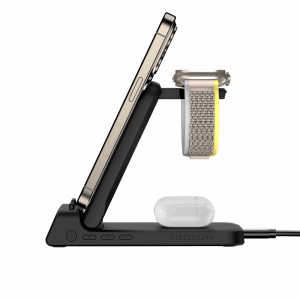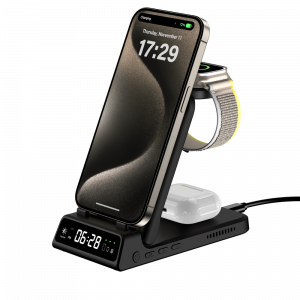The Development History and Pros and Cons of Wireless Chargers
Experience the Future of Charging: SwanScout Redefines Wireless Power with Cutting-Edge Solutions.
DOVER, DELAWARE, UNITED STATES, May 28, 2024 /EINPresswire.com/ -- Development History of Wireless ChargersThe history of wireless charging technology can be traced back to the late 19th century. The earliest concept of wireless energy transmission was proposed by Nikola Tesla. In the 1890s, Tesla invented the Tesla coil, a device capable of transmitting electricity wirelessly over a certain distance. Although the technology was not mature at the time, Tesla's innovation laid the foundation for future wireless charging technology.
In the 20th century, scientists and engineers continued to research wireless energy transmission. In 2006, a research team at the Massachusetts Institute of Technology (MIT) achieved wireless energy transmission through magnetic resonance coupling technology, opening up new avenues for the development of modern wireless charging technology. This breakthrough technology allows electricity to be transferred from a transmitter to a receiver without the need for physical connections.
In the early 21st century, with the widespread popularity of portable electronic devices such as smartphones and tablets, wireless charging technology gradually became commercialized. In 2008, the Wireless Power Consortium (WPC) was established, and the Qi (pronounced "chee") wireless charging standard was introduced. The introduction of the Qi standard accelerated the popularization of wireless charging technology, leading to an increasing number of devices supporting wireless charging.
In recent years, with the continuous advancement of technology, the charging efficiency and transmission distance of wireless chargers have significantly improved. Today, wireless charging is not only used in small electronic devices but also gradually expanding to fields such as electric vehicles and medical devices.
Advantages of Wireless Chargers
1. **Convenience**: One of the greatest advantages of wireless chargers is convenience. Users do not need to plug and unplug cables; they simply place their devices on the charging pad to initiate charging. This convenience greatly enhances the user experience.
2. **Reduced Wear and Tear**: Using wireless chargers can reduce wear and tear on charging ports. Traditional wired charging requires frequent plugging and unplugging, which can lead to loose or damaged ports. Wireless charging eliminates physical contact, helping to extend the lifespan of devices.
3. **Safety**: Wireless charging technology incorporates multiple protection mechanisms to prevent issues such as overcharging and excessive current, ensuring the safety of the charging process. Additionally, wireless chargers typically lack exposed metal contacts, reducing the risk of electric shock.
4. **Aesthetic Appeal**: Wireless chargers reduce cable clutter, making desktops and surfaces more aesthetically pleasing. For those who value simplicity and tidiness, wireless chargers are an ideal choice.
Disadvantages of Wireless Chargers
1. **Charging Efficiency**: Although wireless charging technology continues to improve, charging efficiency is still lower compared to wired charging. Wireless chargers lose some electrical energy during transmission, resulting in slower charging speeds than wired charging.
2. **Device Compatibility**: While the Qi standard has been widely adopted, some devices do not support wireless charging. Furthermore, compatibility issues between different brands and models of wireless chargers and devices may result in suboptimal charging performance.
3. **Transmission Distance Limitations**: Currently, most wireless chargers have limited effective charging distances, typically not exceeding a few centimeters. Devices must be precisely placed on the charging pad for charging, which limits flexibility in usage.
4. **Cost**: Manufacturing costs for wireless chargers are typically higher, resulting in higher retail prices. This may be a consideration for budget-conscious consumers.
SwanScout's Improvements and Upgrades
As an emerging brand in the wireless charger market, SwanScout is committed to continuously improving and upgrading wireless chargers while catering to consumer needs.
1. **Enhanced Charging Efficiency**: SwanScout has increased charging efficiency by adopting advanced magnetic resonance technology and optimizing circuit designs. We continuously research new materials and technologies to approach or even surpass wired charging speeds.
2. **Expanded Device Compatibility**: To ensure more devices can utilize our wireless chargers, SwanScout actively collaborates with major device manufacturers to expand compatibility. Our chargers are compatible with multiple brands and models, ensuring users do not need to worry about compatibility issues.
3. **Increased Transmission Distance and Flexibility**: SwanScout's research team is dedicated to increasing the effective transmission distance of wireless chargers to improve user experience. Through innovative design and technology, our wireless chargers can efficiently transmit power over greater distances, reducing the strict placement requirements for devices.
4. **Cost Reduction**: We optimize production processes and supply chain management to reduce the manufacturing costs of wireless chargers. SwanScout aims to provide high-value products, allowing more consumers to enjoy the convenience of wireless charging.
5. **Improved User Experience**: SwanScout values user feedback and continuously improves product design. Our wireless chargers not only offer powerful functionality but also prioritize aesthetics and user experience, ensuring users enjoy convenience and satisfaction during the charging process.
Conclusion
Wireless charging technology has undergone significant development since its inception in the late 19th century. From Tesla's early explorations to the application of modern magnetic resonance coupling technology, wireless chargers have become commonplace in daily life. While wireless chargers offer advantages such as convenience, reduced wear and tear, safety, and aesthetic appeal, their disadvantages, including lower charging efficiency, device compatibility issues, transmission distance limitations, and higher costs, cannot be ignored. As an emerging brand, SwanScout strives to address these issues through continuous improvement and innovation, providing consumers with more efficient, convenient, and affordable wireless charging solutions. With the ongoing advancement of technology, wireless chargers are expected to become even more efficient and widespread in the future.
Swanscout
Swanscout
email us here
Legal Disclaimer:
EIN Presswire provides this news content "as is" without warranty of any kind. We do not accept any responsibility or liability for the accuracy, content, images, videos, licenses, completeness, legality, or reliability of the information contained in this article. If you have any complaints or copyright issues related to this article, kindly contact the author above.



